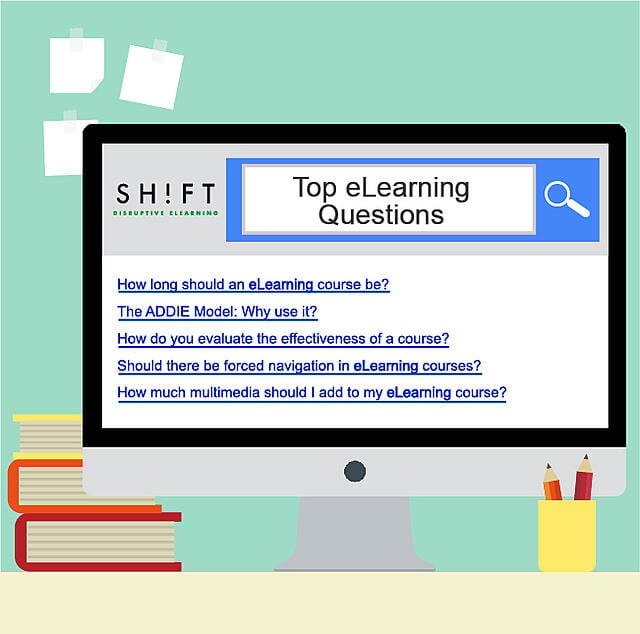In our work with clients, we hear many of the same questions over and over again. Well, here are your answers. It may even be you didn't know you had these questions yet, but rest assured, you will at some point.

Question 1: How long should an eLearning course be?
Answer: There isn't a simple and unique response for this question. The variables can be many. But as a best practice, most courses should clock in around the 10-15 minute mark and avoid going beyond 30 minutes.
This time frame matches the length of time most adults can hold their attention on one thing, and matches the ebb and flow of the work day. Assuming that learners can take a 60-minute eLearning course at their desk and maintain their interest is a myth. About 10-15 minutes is all the time workers have today to do something uninterrupted at their desk. Interrupting longer modules slows the learner down and can interfere with the learning process.
To fit a course module into that time frame, strip the course content down to the essential elements. Select just what is needed to be learned and no more. And if you think your content can’t be presented in less than 20 minutes, chunk the learning into 10-minute sections learners can access one at a time.
Question 2: The ADDIE model. Why use it?
Answer: ADDIE stands for analysis, design, development, implementation and evaluation. We advocate it as the best instructional design process for our partners and clients because of its purposeful and deliberate approach to course design.
ADDIE works as a road map, allowing designers to see both the big picture of the course and how each step in the process builds on the next. The way it is set allows to logically and orderly describe in each phase the most important tasks to develop throughout the process, so you don’t miss anything. Because this instructional design model encourages thoughtful planning, it helps save money and time while also producing the results you want for your course.
Just like you wouldn’t imagine designing and building a product without a process, you also shouldn’t start an eLearning project without using ADDIE.
Question 3: How do you evaluate course effectiveness?
Answer: You can measure the effectiveness of eLearning courses in several ways, but it's always an important step. If a course didn't achieve its goal, it means a waste of time, energy and resources.
The Phillips model measures training outcomes at five levels. Our experts recommend assessing effectiveness using one of five different levels, depending on the original intent of the course.
- Level 1 assesses customer satisfaction with the course. Were learners satisfied?
- Level 2 evaluates what learners learned. Did they pass the test at the end of the course?
- Level 3 looks at behavior. Did behavior in your organization change after participants took the course?
- Level 4 evaluates performance. Did a performance marker move after the course?
- Level 5 assesses financial benefit. Did you see a financial benefit after the training that outweighed the cost of the eLearning course?
Evaluation of a course will vary based on what you hoped to achieve through the course in the first place.
Question 4: Should there be forced navigation in eLearning courses?
Answer: It's not recommended.
Open navigation instead delivers big time results. By unlocking the navigation and letting users backtrack or skip ahead as they feel necessary, moving past screens of content they already understand or jumping to a particular chapter that they want to review, designers can make the content more accessible and help users feel more engaged.
Great eLearning turns old-school classroom dynamics around so that learners have more say, not less, in how they learn, a shift happening in traditional education as well.
Learners have different learning styles, come to courses with different experiences, and have different competencies that courses must take into account. Additionally, the goal of an online course is to transfer knowledge and skills, which won't happen through forced navigation.
Question 5: How much multimedia should a course contain?
Answer: The instinct with eLearning is often to add more multimedia to engage the learner. But, more is often less. Too much becomes overly distracting, redundant and useless.
Keep in mind three essentials when choosing multimedia elements:
- Plan for the minimum user connection when choosing the size of multimedia, or some users won't be able to access the images or videos.
- Less multimedia reduces the overall cost of the course.
- Avoid relying on audio only. Learners don't need the entire course read to them. Use it wisely and to enhance the course.
Didn't get your question answered? Tell us here!









